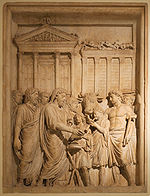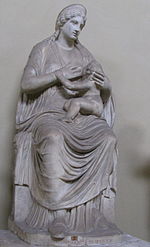- Di nixi
-
 Marcus Aurelius (head covered)
Marcus Aurelius (head covered)
sacrificing at the Temple of JupiterPractices and beliefsImperial cult · festivals · ludi
mystery religions · funerals
temples · auspice · sacrifice
votum · libation · lectisterniumPriesthoodsCollege of Pontiffs · Augur
Vestal Virgins · Flamen · Fetial
Epulones · Arval Brethren
Quindecimviri sacris faciundisJupiter · Juno · Neptune · Minerva
Mars · Venus · Apollo · Diana
Vulcan · Vesta · Mercury · CeresOther deitiesJanus · Quirinus · Saturn ·
Hercules · Faunus · Priapus
Liber · Bona Dea · Ops
Chthonic deities: Proserpina ·
Dis Pater · Orcus · Di Manes
Domestic and local deities:
Lares · Di Penates · Genius
Hellenistic deities: Sol Invictus · Magna Mater · Isis · Mithras
Deified emperors:
Divus Julius · Divus Augustus
See also List of Roman deitiesRelated topicsRoman mythology
Glossary of ancient Roman religion
Religion in ancient Greece
Etruscan religion
Gallo-Roman religion
Decline of Hellenistic polytheism
In ancient Roman religion, the di nixi (or dii nixi), also Nixae, were birth deities. They were depicted kneeling or squatting,[1] a more common birthing position in antiquity than in the modern era.[2] The 2nd-century grammarian Festus explains their name as the participle of the Latin verb nitor, niti, nixus, "to support oneself," also "strive, labor," in this sense "be in labor, give birth."[3] The late Republican scholar Varro said that enixae was the term for women in labor brought about by the Nixae, who oversee the types of religious practices that pertain to those giving birth.[4] In some editions of Ovid's Metamorphoses, a phrase is taken as referring to the birth goddess Lucina and her counterparts the Nixi.[5]
A statuary group of three kneeling nixi or nixae stood in front of the Temple of Minerva on the Capitoline Hill. These had been brought to Rome by Manius Acilius Glabrio among the spoils seized from Antiochus the Great after his defeat at Thermopylae in 191 BC, or perhaps from the sack of Corinth in 146.[6]
In the iconography of Greek myth, the kneeling pose is also found in representations of Leto (Roman Latona) giving birth to Apollo and Artemis (Diana), and of Auge giving birth to Telephus, son of Herakles (Hercules).[7] While the ancient Greek gynecologist Soranos had disapproved of giving birth on one's knees as "painful and embarrassing,"[8] he recommends it for the obese and for lordotic women, that is, those with a concave curvature of the lower back that would tilt the uterus out of alignment with the birth canal.[9]
As guardians of the threshold of life, the Nixi or Nixae may also have been associated with new life in the sense of theological rebirth, or salvation.[10] An altar of the Nixae, within the Tarentum in the general area of the Campus Martius, was the site of the annual sacrifice of the October Horse.[11] The altar was possibly underground, as was the nearby altar of Dis Pater and Proserpina.[12] The Tarentum[13] gave its name to the ritual games held there (ludi tarentini)[14] that became the Saecular Games. A lengthy inscription[15] marks the occasion of these games under Augustus in 17 BC and notes a nocturnal sacrifice carried out for the Ilithyis, or Eileithyiai, the Greek counterparts of the Nixae as birth goddesses.[16] The phrase nuptae genibus nixae ("brides laboring on their knees") appears twice in this invocation. The attitude of devotion or reverence expressed by genibus nixae or genu nixa, which might also be translated as "on bended knee," is formulaic in Latin texts and inscriptions.[17]
It has been suggested that the iconography of kneeling became associated with birth because women sought divine aid for what was often a life-threatening experience in the ancient world. Kneeling also played a role in initiation ritual for mystery religion, which offered the promise of rebirth.[18] Women prayed and held sacred banquets at the Saecular Games, which were characterized by an "overt and unusual celebration of women, children, and families in a civic festival." The role of women on this occasion was consonant with the Augustan emphasis on families as necessary to the vitality of the Roman state.[19]
Robert E.A. Palmer has speculated that the area where the altar of the Nixae was located (Piazza Navona) continued to have significance into the modern Christian era:
“ The shadow of the Nixae hangs over St. Augustine's. For hours I have sat facing the inside of the central portal of this church which is always sealed to accommodate the hundreds of exvotos for the statue of the seated Madonna del (Divin) Parto [Our Lady of Divine Childbirth] and I have watched by candlelight scores of Roman women touch certain parts of that Christian idol in a given order. Who can say whether St. Tryphon's had housed a similar Mother of God and whether she traced her pedigree to Mother Earth or the Isis with the Infant Harpocrates?[20] ” See also
- Ciconiae Nixae, a landmark listed in the 4th-century regionaries, but probably two separate sites, the Ciconiae, or "Storks," perhaps a sculpture, and the altar to the di nixi in Region IX.
References
- ^ Pierre Grimal, The Dictionary of Classical Mythology (Blackwell, 1986, 1996, originally published 1951 in French), pp. 311–312 online.
- ^ Charles J. Adamec, "Genu, genus," Classical Philology 15 (1920), p. 199 online; J.G. Frazer, Pausanias's Description of Greece (London, 1913), vol. 4, p. 436 online; Marcel Le Glay, "Remarques sur la notion de Salus dans la religion romaine," La soteriologia dei culti orientali nell' imperio romano: Études préliminaires au religions orientales dans l'empire romain, Colloquio internazionale Roma, 1979 (Brill, 1982), p. 442 online.
- ^ Nixi Dii appellabantur, quos putabant praesidere parientium nixibus, p. 175 in Müller's edition.
- ^ Varro as preserved by Nonius: enixae dicuntur feminae nitendi, hoc est conandi et dolendi, labore perfunctae: a Nixis quae religionum genera parientibus praesunt.
- ^ Lucinam Nixosque pares, Ovid, Metamorphoses 9.294; M.N. Tod and A.J.B. Wace, A Catalogue of the Sparta Museum (Oxford: Clarendon Press, 1906), p. 117 online.
- ^ Festus: Nixi Di appellantur tria signa in Capitolio ante cellam Minervae genibus nixibus, velut praesidentes parentium nixibus. Quae signa sunt qui memoriae prodiderint Antiocho rege Syriae superato M'. Acilium subtracta a populo Romano adportasse, atque ubi sunt posuisse. Etiam qui capta Corintho advecta huc, quae ibi subiecta fuerint mensae. Latin text as presented by G. Sauron, "Documents pour l'exégèse de la mégalographie dionysiaque de Pompeii," in Ercolano, 1738–1988: 250 anni di ricerca archeologica («L'Erma» di Bretschneider, 1993), p. 358 online.
- ^ W.W. How and J. Wells, A Commentary on Herodotus (Oxford University Press, 1912, reprinted 2002), vol. 2, p. 48 online; Frazer, Pausanias's Description of Greece, p. 436.
- ^ Soranus of Ephesus, Gyn. 2.5, as cited by Sauron, "Documents pour l'exégèse de la mégalographie dionysiaque de Pompeii," p. 358 (this does not correspond to the numbering by Temkin following).
- ^ The idea is that kneeling should tilt the uterus forward and align it with the cervix. For an English translation of the relevant passage, see Soranus' Gynecology, translated by Owsei Temkin (Johns Hopkins University Press, 1956), p. 184 online. See also p. 177 on lordosis and obesity in pregnancy.
- ^ Le Glay, "Remarques," pp. 431–433.
- ^ Ad nixas; William Warde Fowler, The Roman Festivals of the Period of the Republic (London, 1908), p. 242.
- ^ Comment by H.S. Versnel in response to Le Glay, "Remarques," p. 442.
- ^ John H. Humphrey, Roman Circuses: Arenas for Chariot Racing (University of California Press, 1986), pp. 558, 560; Le Glay, "Remarques," p. 442.
- ^ The name is far less likely to have come from Tarentum in Apulia; Erich S. Gruen, "Poetry and Politics: The Beginnings of Latin Literature," in Studies in Greek Culture and Roman Policy (Brill, 1990), p. 83, note 17 online; Calvert Watkins, How to Kill a Dragon: Aspects of Indo-European Poetics (Oxford University Press, 1995), devotes a chapter to the meaning of tarentum.
- ^ Available at LacusCurtius online.
- ^ Sauron, "Documents pour l'exégèse de la mégalographie dionysiaque de Pompeii," p. 358; Le Glay, "Remarques," p. 442.
- ^ For instance, variations in Plautus, Rudens 695; Vergil, Aeneid 3.607; Tibullus 1.2.85f.; Apuleius, the Cupid and Psyche tale, Metamorphoses 6.3. See Sauron, "Documents pour l'exégèse de la mégalographie dionysiaque de Pompeii," p. 358; R. B. Onians, The Origins of European Thought about the Body, the Mind, the Soul, the World, Time, and Fate (Cambridge University Press, 1951, 2000), p. 185 online.
- ^ Sauron, "Documents pour l'exégèse de la mégalographie dionysiaque de Pompeii," pp. 357–358.
- ^ Beth Severy, Augustus and the Family at the Birth of the Roman Empire (Routledge, 2003), p. 58 online.
- ^ Robert E.A. Palmer, Studies of the Northern Campus Martius in Ancient Rome (American Philosophical Society, 1990), p. 57.
Categories:- Roman goddesses
- Childhood goddesses
Wikimedia Foundation. 2010.

